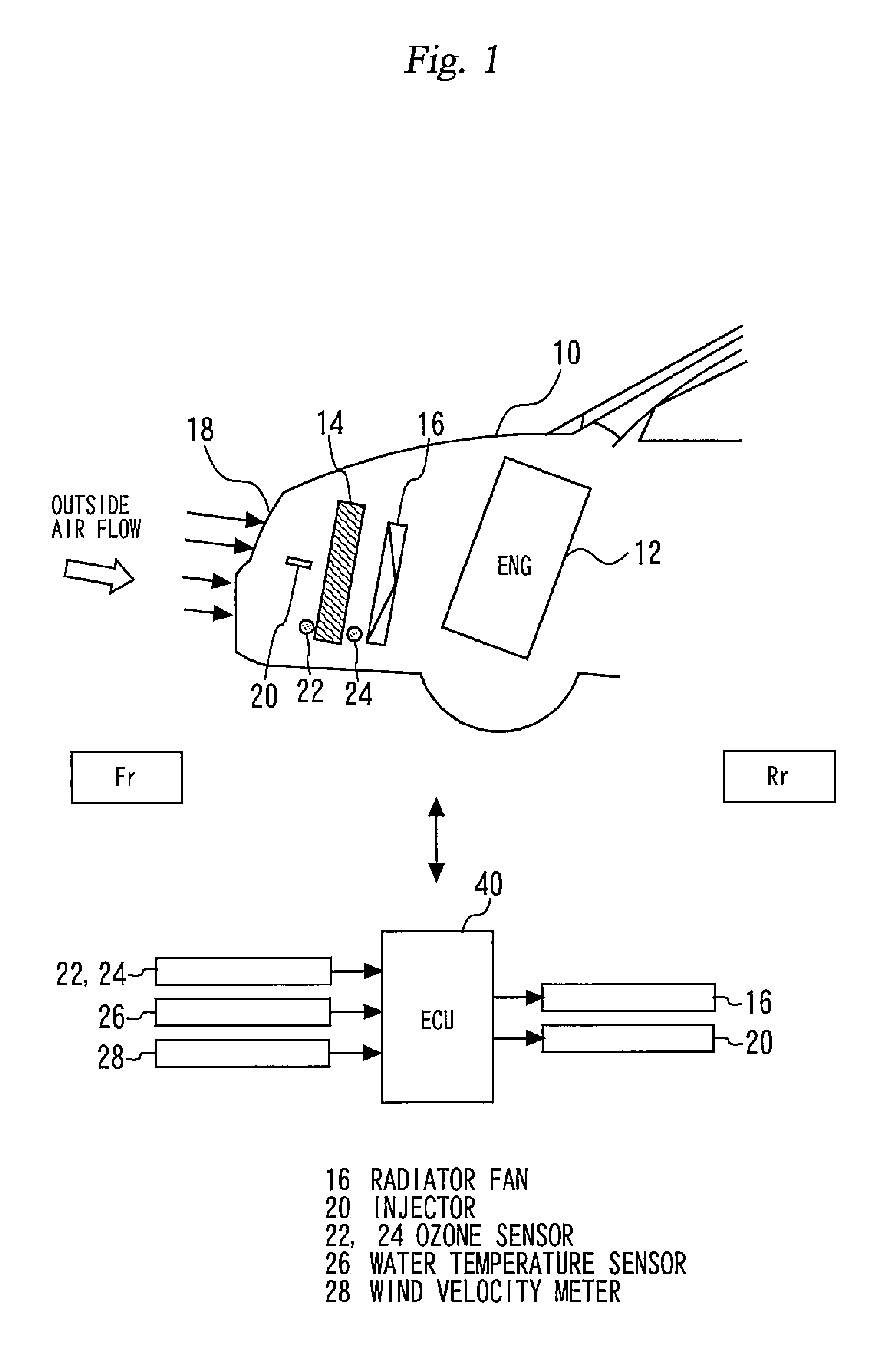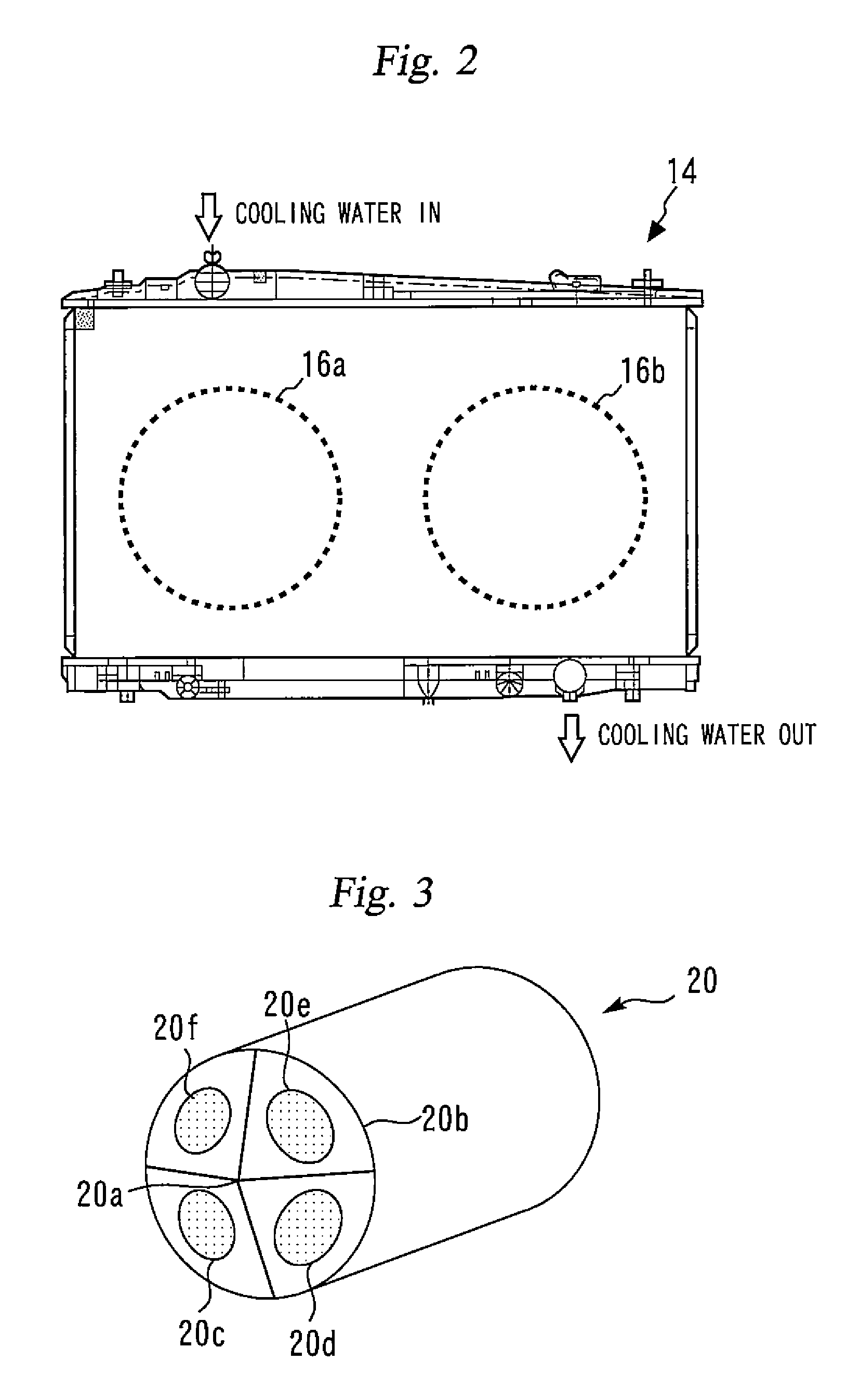Atmosphere-cleaning device for vehicles
a technology for cleaning devices and vehicles, which is applied in the direction of chemistry apparatus and processes, separation processes, and dispersed particle separation, etc., can solve the problems of physical blockage of purification sites, deterioration of the function of ozone purifying bodies, and clogging of purification sites, so as to facilitate the evaporation of adhesion moisture, promote functional restoration, and facilitate the effect of adhesion moistur
- Summary
- Abstract
- Description
- Claims
- Application Information
AI Technical Summary
Benefits of technology
Problems solved by technology
Method used
Image
Examples
embodiment 1
[Configuration of Atmosphere-Cleaning Device for Vehicles]
[0101]First, Embodiment 1 of the present invention will be described while referring to FIG. 1 to FIG. 13. FIG. 1 is a view that illustrates the configuration of a vehicle in which an atmosphere-cleaning device according to the present embodiment is mounted. A vehicle 10 shown in FIG. 1 includes an internal combustion engine 12 as a power apparatus. HC and NOx are contained in exhaust gas that is discharged from the internal combustion engine 12. Ozone is generated by a photochemical reaction in which HC or NOx acts as a reactant. Consequently, the impact the vehicle 10 has on the environment can be reduced by mounting an atmosphere-cleaning device in the vehicle 10 and purifying ozone contained in atmospheric air entering the vehicle 10 while the vehicle 10 is travelling.
[0102]In the vehicle 10, a radiator 14 that cools cooling water that circulates in the internal combustion engine 12 is arranged in front of the internal co...
embodiment 2
[0133]Next, Embodiment 2 of the present invention will be described while referring to FIG. 14 and FIG. 15. A feature of the present embodiment is that the atmosphere-cleaning device includes an injector that is connected to a low-pressure tank (hereunder referred to as “low-pressure injector”) and an injector that is connected to a high-pressure tank (hereunder referred to as “high-pressure injector”) instead of the injector 20 of the above described Embodiment 1, and executes an extraneous substance removal control routine illustrated in FIG. 15. Therefore, a detailed description of the configuration of the atmosphere-cleaning device and of the extraneous substance removal control will be omitted here.
[Extraneous Substance Removal Control in Embodiment 2]
[0134]As described in the foregoing Embodiment 1, the reason for injecting a cleaning liquid from the injector 20 is to raise the fluidity of extraneous substances that clog purification sites so that the extraneous substances are...
embodiment 3
[0148]Next, Embodiment 3 of the present invention will be described while referring to FIG. 16 and FIG. 17. A feature of the present embodiment is that the above described extraneous substance removal control is executed while the vehicle 10 is stopped. Therefore, a detailed description of the configuration of the atmosphere-cleaning device and of the extraneous substance removal control will be omitted here.
[Extraneous Substance Removal Control in Embodiment 3]
[0149]The extraneous substance removal control in the foregoing Embodiments 1 and 2 is executed while the vehicle 10 is travelling. However, in a case where operations in which the internal combustion engine 12 is stopped a short time after operation of the internal combustion engine 12 was started (so-called “short-trip driving”) are repeated, there is a possibility that extraneous substances cannot be adequately removed during a drive cycle. Therefore, according to the present embodiment a configuration is adopted that exec...
PUM
| Property | Measurement | Unit |
|---|---|---|
| temperature | aaaaa | aaaaa |
| velocity | aaaaa | aaaaa |
| temperature | aaaaa | aaaaa |
Abstract
Description
Claims
Application Information
 Login to View More
Login to View More - R&D
- Intellectual Property
- Life Sciences
- Materials
- Tech Scout
- Unparalleled Data Quality
- Higher Quality Content
- 60% Fewer Hallucinations
Browse by: Latest US Patents, China's latest patents, Technical Efficacy Thesaurus, Application Domain, Technology Topic, Popular Technical Reports.
© 2025 PatSnap. All rights reserved.Legal|Privacy policy|Modern Slavery Act Transparency Statement|Sitemap|About US| Contact US: help@patsnap.com



